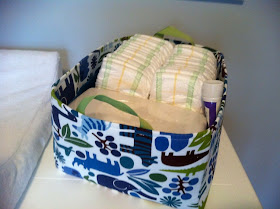 I am a huge fan of open storage. I like to be able to throw something in a bin easily and not worry about taking off or putting on a lid. (I'm lazy, I know.)
I am a huge fan of open storage. I like to be able to throw something in a bin easily and not worry about taking off or putting on a lid. (I'm lazy, I know.) Both kids have the ClosetMaid Cubeicals in their closets to store books and other things. There are lots of storage options for these, but I've never liked how their fabric bins take up the entire square. It makes it difficult to just chuck something in, or to see what is in the bin from far away. I am both a slob and obsessive about organization, so I need something that can be organized chaos.
I found this great tutorial for fabric baskets and thought I could adjust the measurements to fit the Cubeicals. It was important to me that it was wide enough to fit a tub of wipes and a stack of diapers, and short enough to leave some room when put in the Cubeical. I also wanted something that could serve as a diaper storage bin for the top of the changing table when needed, but be able to be put away in the Cubeical when not in use.
Here are the measurements I used (replacing what is in the tutorial link above) -
Exterior Fabric - 2 pieces 11"x10", 1 piece 12"x29"
Interior Fabric - 2 pieces 11"x6.5", 2 pieces 12"x6.5", 1 piece 13"x14"
Interfacing - 2 pieces 11"x10", i piece 12"x29"
I used a combination of sew-in and iron-on interfacing, mainly because I didn't know what I was doing when I went to the fabric store. Having used both - the iron-on is a lot easier, but more expensive. The sew-in isn't hard, but takes a little more effort. Just make sure you baste it in so it's easier to take out if you screw it up. (This is experience talking here.)
I used some foam core I had lying around for the bottom piece, and some old ribbon for the handles. If I were doing it again, I would probably use something a little sturdier so they would stand up better.
I was only going to make one, but they were so easy I ended up making three. With basic sewing skills, I'd say this takes 3-4 hours each. I did the second and third simultaneously, which helped speed things up a bit.
Want to customize this for yourself? Here's the formula I used to determine what size fabric I needed to cut.
For the exterior fabric:
2 of these: (Finished Width +1 inch) X (Finished Height + 3 inches) (for the front and back)
1 of these: (Finished Depth + 1 inch) X (2xFinished Height + Finished Width + 5inches) (for the bottom and sides)
For the interior:
2 of these: (Finished Width + 1 inch) X (Finished Height - 1/2 inch) (for the front and back)
2 of these: (Finished Depth + 1 inch) X (Finished Height - 1/2 inch) (for the sides)
1 of these: (Finished Width + 3 inches) X (Finished Depth + 3 inches) (for the bottom)
Interfacing: Same formula as the exterior.










